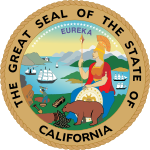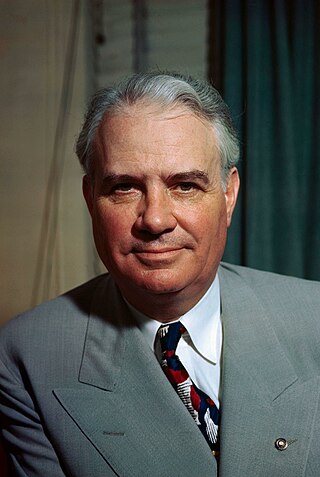
John William Bricker was an American politician and attorney who served as a United States senator and the 54th governor of Ohio. He was also the Republican nominee for Vice President in 1944.

Thomas Henry Kuchel was an American politician. A moderate Republican, he served as a US Senator from California from 1953 to 1969 and was the minority whip in the Senate, where he was the co-manager on the floor for the Civil Rights Act of 1964 and the Voting Rights Act of 1965. Kuchel voted in favor of the Civil Rights Acts of 1957, 1960, and 1964, as well as the 24th Amendment to the U.S. Constitution, the Voting Rights Act of 1965, and the confirmation of Thurgood Marshall to the U.S. Supreme Court, while Kuchel did not vote on the Civil Rights Act of 1968.

George Clement Perkins was an American businessman and politician. A member of the Republican Party, Perkins served as the 14th Governor of California from 1880 to 1883, and as United States Senator from California from 1893 to 1915. He also served in the California State Senate.
This article covers the history of women in the United States Senate and various milestones achieved by female senators. It includes a list of all women who have served in the Senate, a list of current female senators, and a list of states represented by women in the Senate. The first female U.S. senator, Rebecca Latimer Felton, represented Georgia for a single day in 1922, and the first woman elected to the Senate, Hattie Caraway, was elected from Arkansas in 1932. Since its establishment in 1789, 60 women have served in the upper house of the United States Congress. As of October 3, 2023, there are 25 women serving as U.S. senators out of 100 possible seats. Additionally, Kamala Harris as vice president serves as President of the Senate.
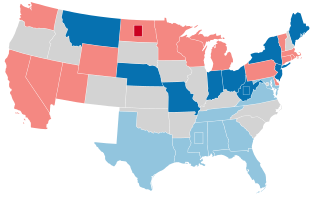
The 1910–11 United States Senate election were held on various dates in various states. As these U.S. Senate elections were prior to the ratification of the Seventeenth Amendment in 1913, senators were primarily chosen by state legislatures. Senators were elected over a wide range of time throughout 1910 and 1911, and a seat may have been filled months late or remained vacant due to legislative deadlock. However, some states had already begun direct elections during this time. Oregon pioneered direct election and experimented with different measures over several years until it succeeded in 1907. Soon after, Nebraska followed suit and laid the foundation for other states to adopt measures reflecting the people's will. By 1912, as many as 29 states elected senators either as nominees of their party's primary or in conjunction with a general election.
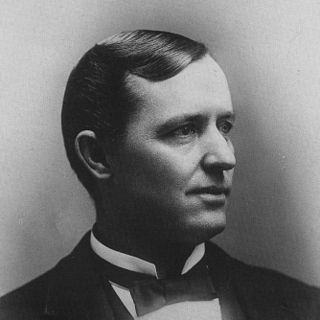
Lee Mantle was an English-born American businessman and politician from Montana. A Republican, he was most notable for his service as a United States Senator from 1895 to 1899.

The 1894–95 United States Senate elections were held on various dates in various states. As these U.S. Senate elections were prior to the ratification of the Seventeenth Amendment in 1913, senators were chosen by state legislatures. Senators were elected over a wide range of time throughout 1894 and 1895, and a seat may have been filled months late or remained vacant due to legislative deadlock. In these elections, terms were up for the senators in Class 2.
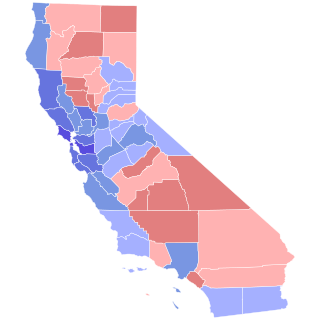
The 1992 United States Senate special election in California took place on November 3, 1992, at the same time as the regular election to the United States Senate in California. Feinstein defeated future California governor Gray Davis in the Democratic primary, while Seymour defeated William E. Dannemeyer in the Republican primary.
The 1893 United States Senate election in New York was held on January 17, 1893, by the New York State Legislature to elect a U.S. Senator to represent the State of New York in the United States Senate.

The 1874–75 United States Senate elections were held on various dates in various states. As these U.S. Senate elections were prior to the ratification of the Seventeenth Amendment in 1913, senators were chosen by state legislatures. Senators were elected over a wide range of time throughout 1874 and 1875, and a seat may have been filled months late or remained vacant due to legislative deadlock. In these elections, terms were up for the senators in Class 1.

The 1900–01 United States Senate elections were held on various dates in various states, coinciding with President William McKinley's re-election as well as the 1900 House of Representatives elections. As these U.S. Senate elections were prior to the ratification of the Seventeenth Amendment in 1913, senators were chosen by state legislatures. Senators were elected over a wide range of time throughout 1900 and 1901, and a seat may have been filled months late or remained vacant due to legislative deadlock. In these elections, terms were up for the senators in Class 2.

The 1890–91 United States Senate elections were held on various dates in various states. As these U.S. Senate elections were prior to the ratification of the Seventeenth Amendment in 1913, senators were chosen by state legislatures. Senators were elected over a wide range of time throughout 1890 and 1891, and a seat may have been filled months late or remained vacant due to legislative deadlock. In these elections, terms were up for the senators in Class 3.

The 1892–93 United States Senate elections were held on various dates in various states, coinciding with former Democratic President Grover Cleveland's return to power. As these U.S. Senate elections were prior to the ratification of the Seventeenth Amendment in 1913, senators were chosen by state legislatures. Senators were elected over a wide range of time throughout 1892 and 1893, and a seat may have been filled months late or remained vacant due to legislative deadlock. In these elections, terms were up for the senators in Class 1.

The 1996 United States Senate election in Maine was held November 5, 1996. Incumbent Republican U.S. Senator William Cohen decided to retire instead of seeking a fourth term. To replace him, U.S. Representative Joseph E. Brennan won the Democratic primary while political consultant Susan Collins won the Republican primary. A competitive general election ensued, but Collins ultimately won out over Brennan, keeping the seat in the Republican column. With Collins' election to the Senate in 1996, Maine became the third state after California and Kansas to have two sitting female senators, and the first to have two elected female Republican senators.

The 1988 United States Senate election in California took place on November 8, 1988. Incumbent Senator Pete Wilson won re-election to a second term.

The 1895 United States Senate special election in California was held on January 23, 1895, by the California State Legislature to elect a U.S. Senator to represent the State of California in the United States Senate. Incumbent Republican Senator George Clement Perkins, who was appointed by Governor Henry Markham to fill the vacancy caused by the death of Senator Leland Stanford in 1893, was re-elected to a full term in office, defeating newspaper publisher and fellow Republican M. H. de Young, Democratic former Lieutenant Governor John Daggett, and several other minor challengers.

The 1911 United States Senate election in New Jersey was held on January 24–25, 1911. Republican incumbent John Kean did not run for re-election to a third term. The open seat was won by Democrat James Edgar Martine with Republican former Governor Edward C. Stokes as the runner-up.

The 1944 United States Senate election in California was held on November 7, 1944.







